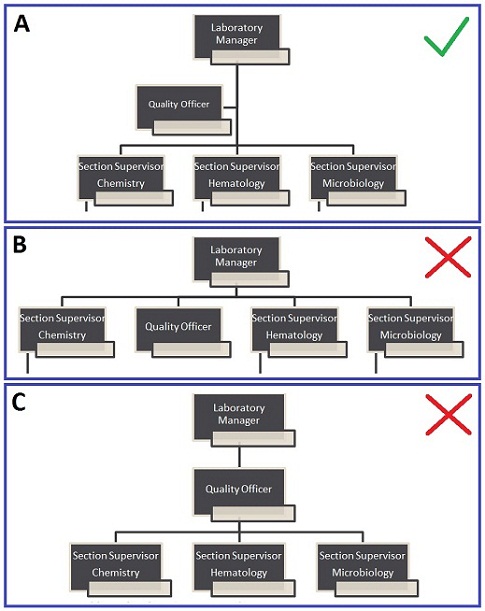
Title
Why
In phase 1 the quality focal person was appointed. Since the implementation of the quality management system is now taking shape it is time to formally hire a Quality Officer. The position of Quality Focal Point will thereby cease to exist.
What
The position "Quality Officer" must be introduced and filled. This can be the same staff member who was first filling the position of Quality Focal Point but this is not mandatory. The core functions of the Quality Officer are:
- Ensuring that the quality management system is implemented and maintained.
- Reporting to Laboratory Management on the performance of the quality management system and needs for improvement.
- Ensuring that all laboratory staff are aware of, and involved in the implementation and maintenance of the quality management system.
The Quality Officer is not an in-line position but an advisory position. The Quality Officer only monitors the implementation and functioning of the quality management system and provides this information to the Laboratory Manager. As such the Quality Officer has an advisory position without authority over other positions in the laboratory. He/she is not responsible for the functioning of others and as such cannot be held accountable for the functioning of the laboratory and the quality management system in particular. The reason why the Quality Officer should not be held accountable for the functioning of the quality management system is that, if this is not the case, the Quality Officer may be restrained from providing negative information about the quality management system in case of poor performance because he/she may fear the consequences for his/her employment. It is the task of the Laboratory Manager to direct other staff members, based on the information provided by the Quality Officer.
In the organizational chart of the laboratory the position of the Quality Officer should therefore be placed on the side-line between the Laboratory Manager and the second layer of positions, as shown in figure A. Placing the Quality Officer in the second layer or in-between the Laboratory Manager and the second layer is incorrect (figure B and C). In both cases the Laboratory Manager has authority over the Quality Officer, making it impossible for the Quality Officer to provide objective, independent advice about the work of others.

How & who
Laboratory Manager:
- Adapt the Authorization Matrix to include the authorities and responsibilities of the position Quality Officer. For instructions see the activity for developing the Authorization Matrix in phase 1.
- Develop a job description for the position of Quality Officer. For instructions see the activity for developing Position Job Descriptions in phase 1.
- Select or recruit a staff member who is suitable to fulfill the position of Quality Officer. Note that being the Quality Officer is a lot of work (especially during the implementation of the quality management system) so the former position of the person hired as Quality Officer needs to be filled by another staff member. If necessary, hire new staff for taking over the Quality Officer's former work or hire an external person as Quality Officer.
- Update the Personal Job Description of the employee hired or appointed as Quality Officer. For instructions see the activity for developing Personal Job Descriptions in phase 1.
- Adapt the Organizational Chart of the laboratory to include the position of Quality Officer. The Quality Officer is an advisory position without subordinates. This means that the Quality Officer has no authority to function as a manager: he/she merely observes the functioning of the quality management system and advises the management on activities that need to be performed. See the Example Organizational Chart above to see what is meant here.
- Organize regular bilateral meetings with the Quality Officer to discuss proceedings (at least once per 2 weeks).

